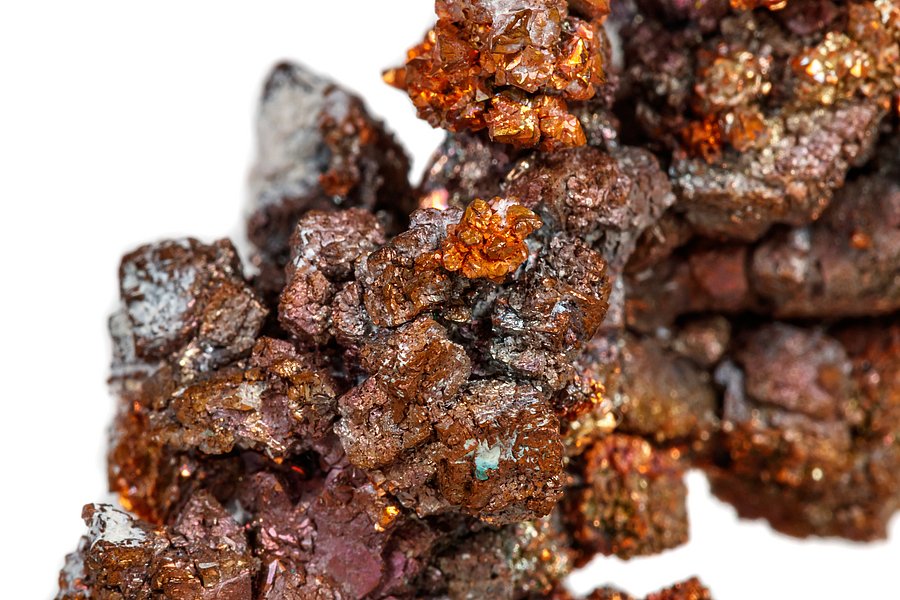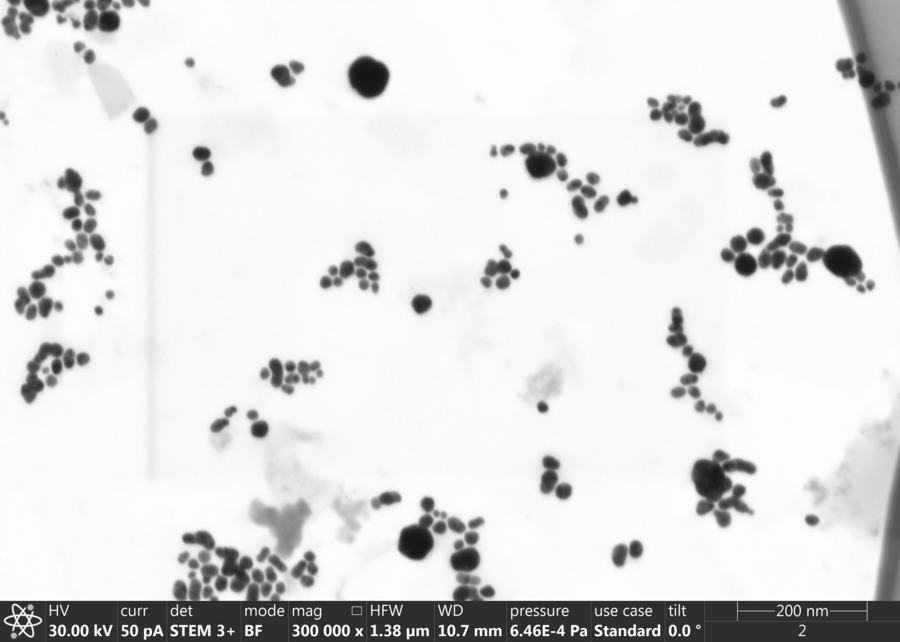Research proposal approved
Achieving great things with small particles: NanoSTeW project breaks new ground in copper processing

In order to make our future sustainable, we need new solutions for dealing with limited resources. A project at the University of Wuppertal now aims to make the use of copper more efficient. // Photo Colourbox
"In the NanoSTeW project, we are looking for a new material composition that is as strong and conductive as possible in order to use it for the production of components in additive manufacturing, i.e. 3D printing. Specifically, we are focussing on copper and addressing a problem that arises with its alloys," says group leader Silja-Katharina Rittinghaus, explaining the project. And that's what's behind it: Copper plays a crucial role in various industrial applications, but also in our everyday lives. For example, in electronic devices to protect against overheating: the metal has a high conductivity so that the heat generated during operation is quickly dissipated by the copper. Although pure copper, which can also be processed as a metallic powder in 3D printers, is the most conductive, it is also a relatively soft material. In order to fulfil the highest technical requirements, the material used must be stronger. This is achieved using copper alloys, i.e. compounds with other metals. The problem is that conventional materials are no longer as conductive as pure copper, meaning that the parts made from them do not utilise the full potential of their cooling capacity. The search is therefore on for new alloys that score highly in terms of thermal conductivity and strength.
Turning three into one
The NanoSTeW project is focussing on tiny parts: Nanoparticles of silver and yttrium oxide. In combination with other elements, silver increases the strength of the metallic material mixture without negatively affecting its conductivity. Yttrium oxide ensures that the material becomes stronger even at high temperatures - also without impairing its conductivity. An innovation is now to combine both materials with copper at the same time. "We have set ourselves the task," summarises Rittinghaus, "of combining copper, silver and yttrium oxide in the best possible way and developing new composite powders for 3D printing and testing them for two applications at the same time." Together with her project mentors, Rittinghaus wants to use the developed material to produce parts for a drive component for the aerospace industry and to coat a ceramic cooler with copper for thermal management in electronic devices and components. In future, the cooler could be used in the field of electromobility, for example in battery management systems, where it helps to control the temperature.

Small but mighty: nanoparticles (photographed here with a transmission electron microscope) are used in the NanoSTeW project to produce copper alloys for various applications. // Image Dr Kateryna Loza, ICAN
For the sake of the environment
As an additional component, the research group is focussing on the recycling process. The aim is to make the entire production of the new material mixture as resource-efficient as possible - at various levels. "On the one hand, we are looking at how useful copper is for our powder, which we can obtain as a secondary raw material from other products. In our project, for example, this is copper from discarded solar panels," explains Rittinghaus. On the other hand, the researchers are considering the question of how the copper from the production trials can be recycled if it does not yet have the desired properties.
Knowledge that can be transferred
Throughout the various project steps, the project brings together scientists with expertise from very different fields: materials science, materials engineering, chemistry and nanotechnology, as well as physics, process engineering and computer science. The project is also supported by mentors from industry. Rittinghaus: "In this way, we want to ensure that both scientific and technical aspects are taken into account and that economic realisation is possible." The fact that the project is developing components for two different applications - aerospace technology and electronics - that differ in terms of their geometric and functional requirements is intended to highlight the potential, flexibility and transferability of the solutions developed to other material systems. "In NanoSTeW, we are using materials research to provide impetus for new applications and to make important technologies more future-proof and sustainable," says Rittinghaus.
About the person: Dr Silja-Katharina Rittinghaus
Silja-Katharina Rittinghaus has been a habilitation candidate at the Chair of Materials Science and Additive Manufacturing under Prof Dr Bilal Gökce since 2022. She initially studied industrial engineering at RWTH Aachen University, specialising in materials and process engineering. Her doctorate took her to the Fraunhofer Institute for Laser Technology, where she worked on high-temperature materials. Her research interests include materials science, materials engineering, powder metallurgy and the development of 3D printing processes. From 1 January 2025, she will head the NanoSTeW junior research group.
Read on for more background
The red gold
Today's areas of application for copper are constantly evolving and new innovative fields of use are being added. Around 26 million tonnes of copper are needed worldwide every year. Due to its properties, it is considered an important technology and functional metal, especially for the energy transition. However, its availability in Germany is limited: The country's own reserves are not sufficient to meet demand in the long term. In order to shape our future sustainably, conserve resources and make the country less dependent on copper imports from abroad, the more efficient use of copper is particularly desirable. This is where the NanoSTeW project comes in: The main aim is to develop new copper materials that can dissipate heat even better than those previously used and to promote the sustainability of copper-containing products by taking a comprehensive look at the material cycles involved. In addition to reducing the ecological footprint of production processes, this has a further effect: "If the thermal conductivity of the materials used can be increased, the systems and the components that cool them also become more efficient and durable. This also helps us to conserve resources," explains research group leader Silja-Katharina Rittinghaus.
How can this be achieved? The project approach
Strength and durability make metals a suitable choice for the 3D printing process. Fusible material, liquids or - as in the case of the NanoSTeW project - powder is heated, remelted layer by layer with laser or electron radiation (high-energy radiation) and built up into a three-dimensional body. The template for the structure is a digital design of the object, which is initially created on a computer using graphics software. Later, a type of translation programme makes the file readable for the printer. In this step, specific settings can also be made for the device, such as contour accuracy and printing speed.

Schematic of composite powder production // Figure based on Goßling et al. (2024), https://doi.org/10.1557/s43578-023-01267-4
Nano-composite production
The first challenge for those involved lies in the production of the composite powder. Newly developed approaches enable the nanoparticles of silver and yttrium oxide and their composites with the copper powder to be produced and processed with minimal use of auxiliary materials. This avoids impurities and oxidation, which would have a negative impact on the material properties. And this is how it works: the researchers first shoot a laser at a solid body of silver or yttrium oxide. This process, known as laser ablation, leads to vaporisation and plasma formation, whereby nanoparticles are released from the solid surface into the liquid and quenched. What is new and therefore one of the innovations of the research approach is the step of combining two different types of nanoparticles with the copper. This process also takes place in a liquid that supports the process. Varying pH values play a role here, causing the nanoparticles to adhere to the copper surface. One advantage of this production method compared to grinding processes, for example, is that the copper powder retains its original shape and can still be easily processed in 3D printing. "In addition," says Rittinghaus, "the overall process is very flexible, meaning that the quantity and even size of the nanoparticles added can be easily varied."

Image taken with a scanning electron microscope: The tiny nanoparticles adhere to the larger copper microparticle - the composite is formed. // Image Tobias Bochman, ICAN
Leaving nothing to chance
Another innovation lies in the design of the subsequent powder processing in 3D printing. "This step is about developing a new process with which the material solidifies in a certain way after being remelted by electron radiation, which ultimately leads to the ideal material properties: thermally conductive and solid," says the scientist, referring to the topic of texture design. The plan is to be able to specifically adjust the microstructure of two- and three-dimensional objects from the printer, for example via the software used in the printing process. This should also ensure an even distribution of the powder components in the end product, which is important for good material properties.
The research group hopes to gain comprehensive scientific knowledge about nanocomposites and their processing technologies: Throughout the entire process - from particle and composite powder production to the printed structure - the material, including its nano- and microstructure, components and the processes used will be repeatedly analysed in order to make reliable statements about the properties of the material and thus the progress of the project. If successful, the new technologies will be implemented together with the project mentors.
Background Junior Research Group NanoSTeW
The Federal Ministry of Education and Research (BMBF) enables young, excellent scientists to acquire funding for their own junior research group as part of several programmes. They are given the opportunity to work on new research questions - often in an interdisciplinary team - to further their scientific qualifications.
The BMBF funds research and development projects in the field of materials science and materials engineering on the basis of the "From Material to Innovation" framework programme. The NanoSTeW junior research group in Wuppertal is being funded for five years with around two million euros in the application field "Sustainable use of raw materials and materials" and is headed by Dr Silja-Katharina Rittinghaus at the University of Wuppertal. NanoSTeW stands for „nanocomposite melting materials and their texture design for efficient heat transport in structural components“.
